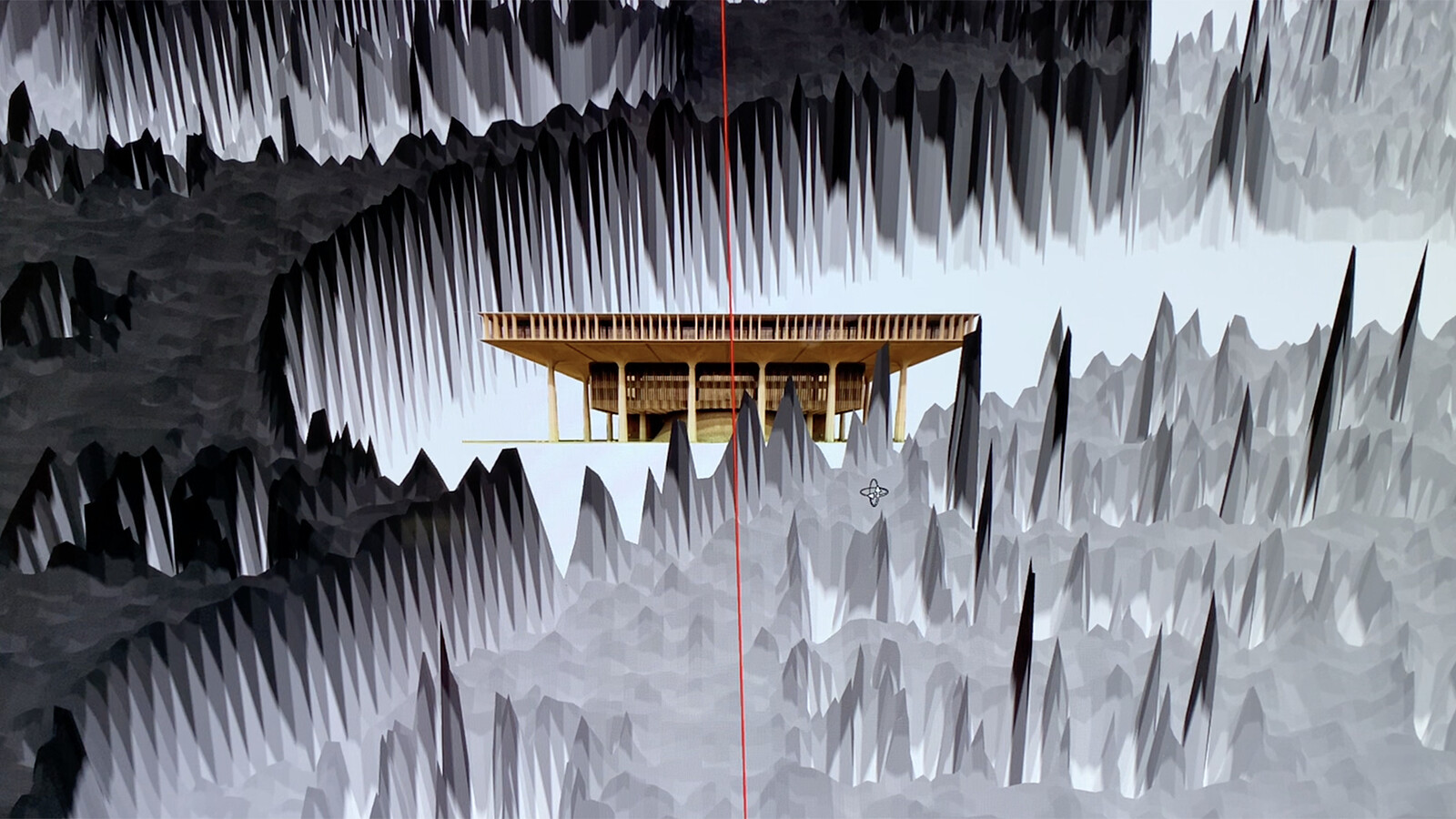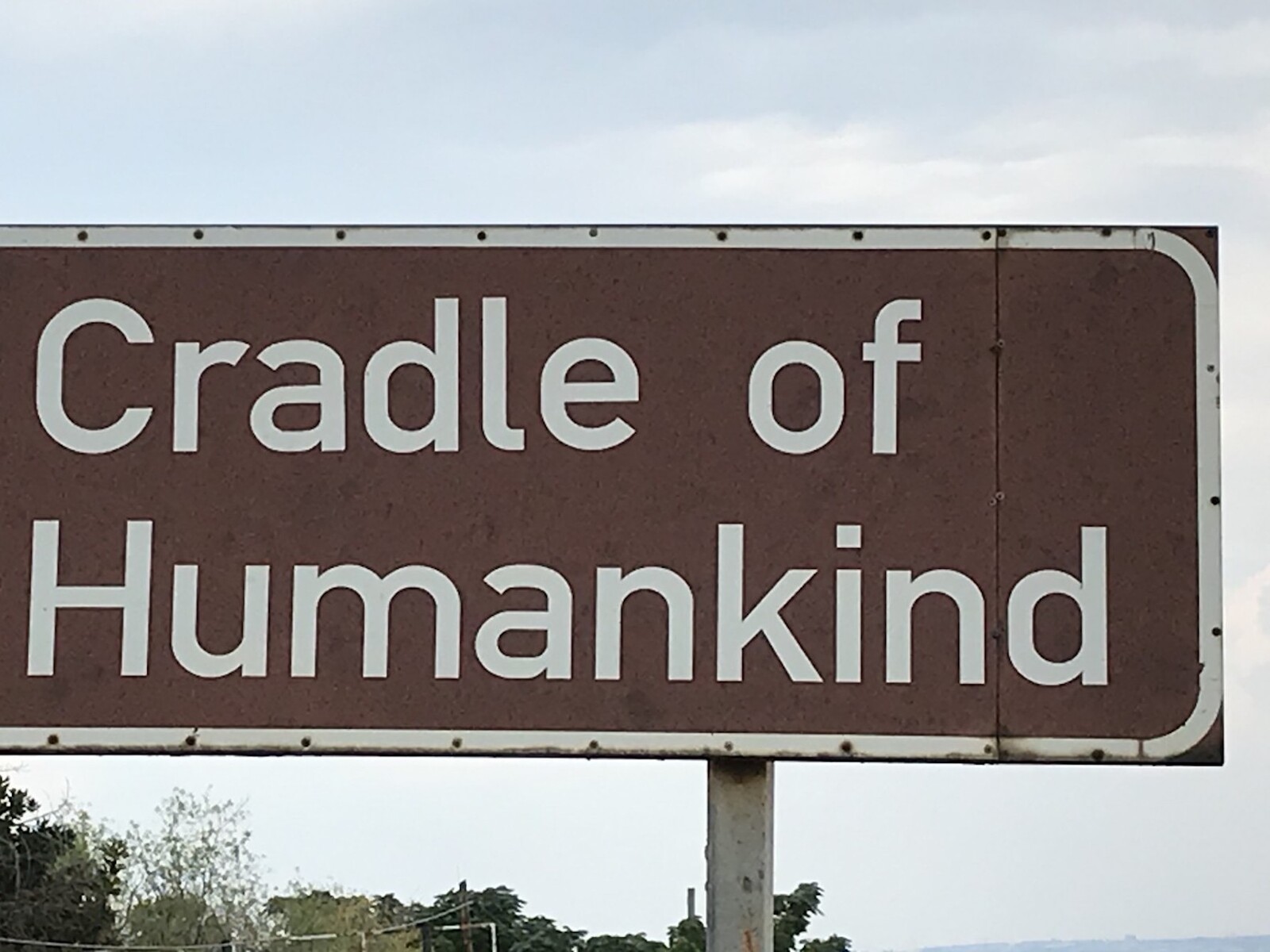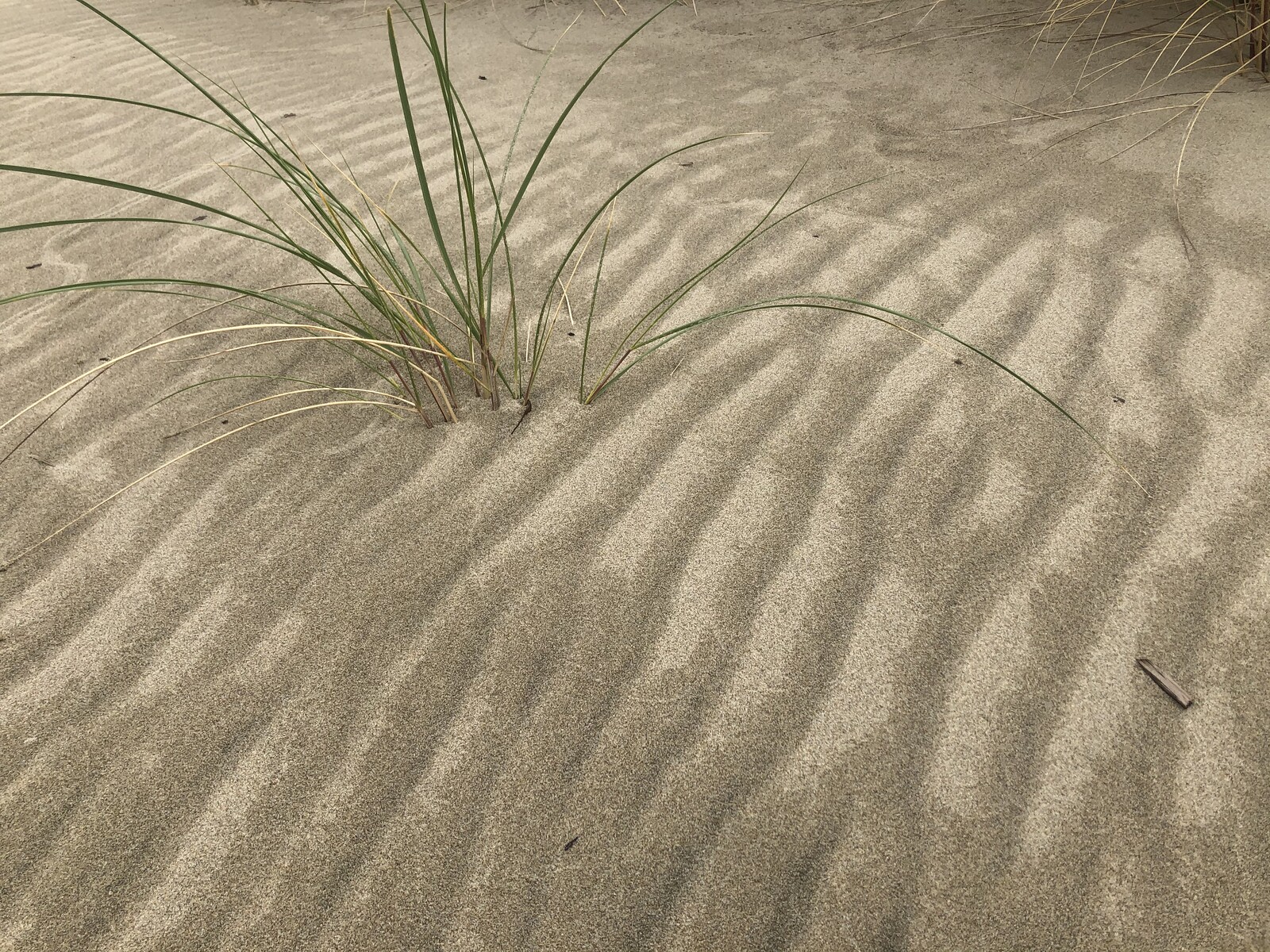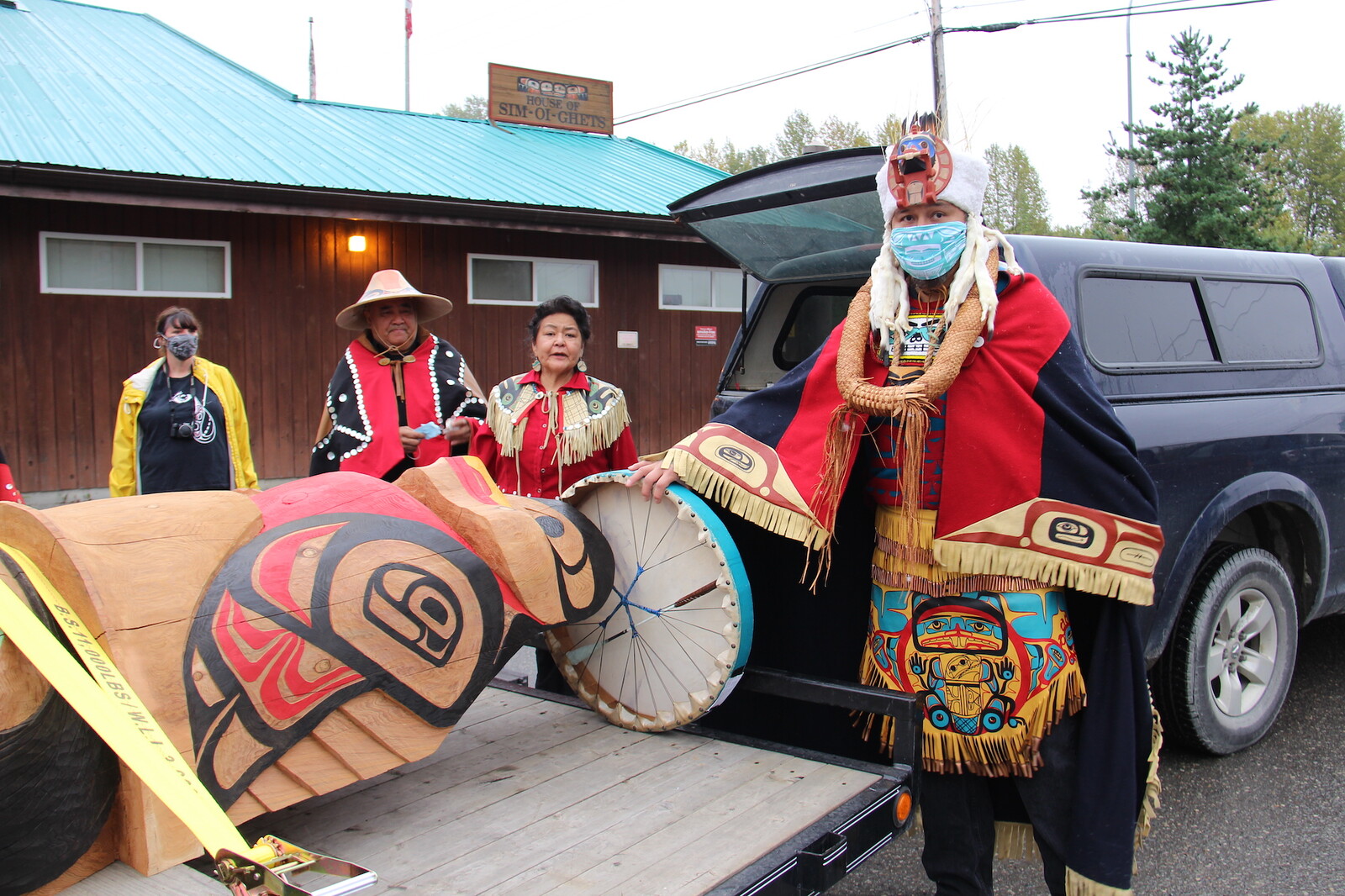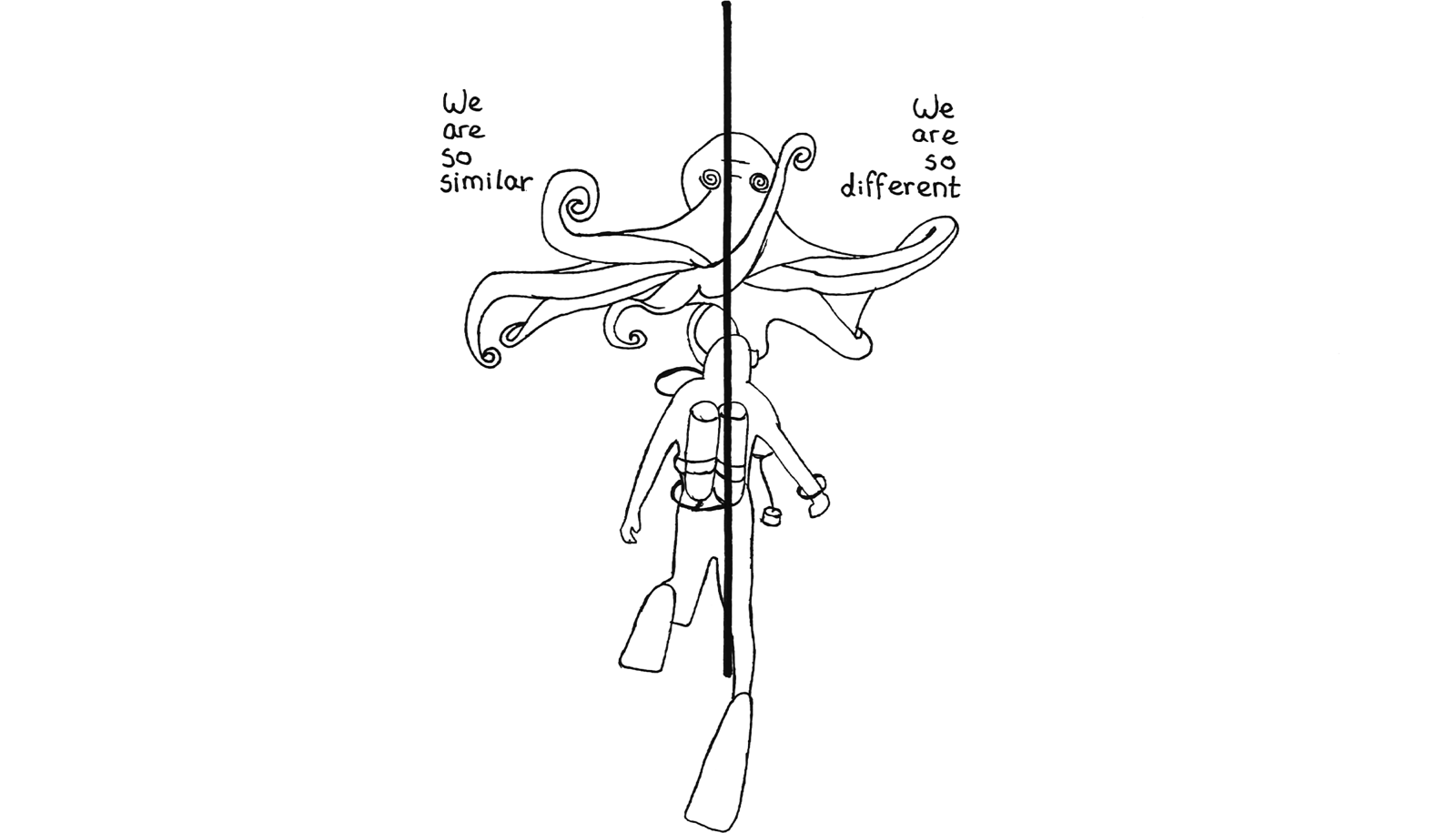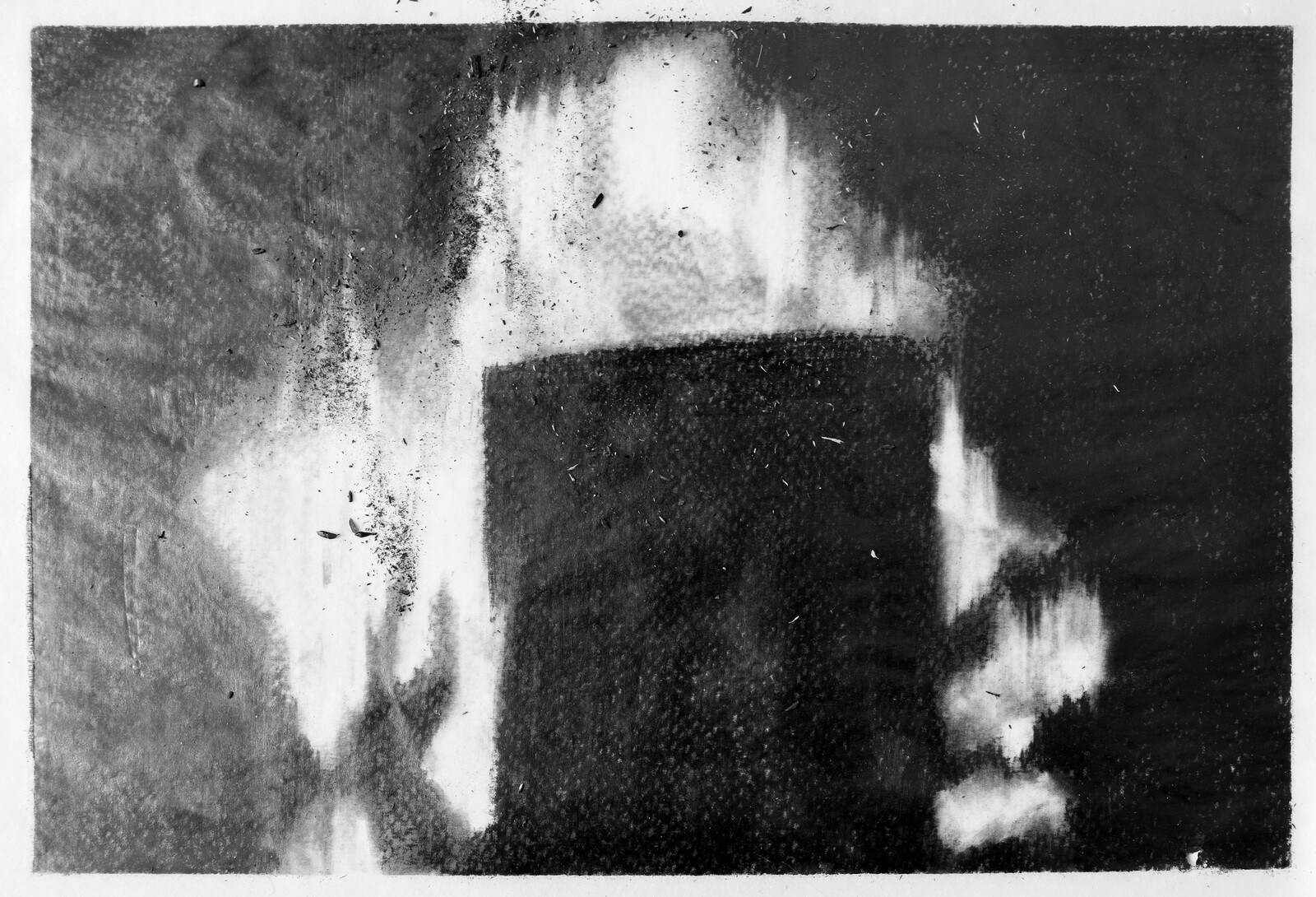Dig. Geology and its kin network of extraction, natural resources, architectures of geomorphic transformation (dams, river straightening, climate change), and redistribution of geologic materials (kitchen sinks, nuclear bunkers, asphalt) and geochemical energy (carbon, nitrogen, phosphorous) mobilizes a normative mode of materiality.1 In this conversion of earth through the grammars of geology, the materializing of epistemic violence enacts a world-building and world-shattering that is characterized by unequal access to geopower (accumulation from geologic materials) and its inverse, exhaustion (exposure to extractive predation).2 Here, two subjective-earth states might be distinguished: 1) those given by extraction (white man’s overburden) and 2) those continuously exposed by extraction processes, such that they are subject to the weight of the overburden (which makes digging yourself out of a hole and hitting rock bottom a constant threat, not to mention the collapse of the earth itself). As extractive predation involves the transfer of energy, it is the means by which racist hetero-reproductive violence is maintained, governed, and regulated. Geology does not merely map the earth, it changes it. The mine is emblematic of that exchange and the conditions of those relations as hierarchical. It is a subterranean spatiality that is always under pressure from the weight of the division of surface and underground states. Yet, the underground is also the possibility and spatial autonomy of opacity in plain sight. It is somewhere to dig in and plot.


The mine is paradigmatic because of what it institutes in terms of spatial and subtending relations, exhibiting a geophysical approach to race. In W. E. B. Du Bois’s terms, whiteness is the ownership of the earth for ever and ever. Mind over matter in the grammars of Enlightenment geology became, in the practical geology of colonialism, mine overmatter, that is, matter recognized by the imperative to extract and accumulate through subtending stratal relations. This is mine in the possessive sense, mine as the mastering of matter through the organization of the grammars of geology around the affective and geochemical work of purity. This move to purity is part of what Denise Ferreira da Silva calls a more general “move to separability.”3 Matter is dividuated based on its ability to function as autonomous mineralogical and metallurgical units. This dividuation eradicates the supplementary actions of geology, as a geochemically communicative matter-state that is already situated in the earth and the relational work of the inorganic. Geochemical matter has different kinds of porosity and promiscuity. Under certain conditions, it mixes and makes new amalgams. It aggregates, often in toxic ways when it is unearthed or segregated from prior relations. The Enlightenment understanding of nature and its “properties” structures material legacies that are a product of colonial relations, its forms of imagining, and practical purification and the policing of categories. Such carceral forms are both a means to property and to the disavowal of the colonial encounter with difference. Geologic grammars of extraction stabilize the material object for the extraction of value and the creation of the commodity form. The psychic splitting of the world and its realization in the material segregations of inhuman, nonhuman, and human matter was a means of controlling and governing that fracture. The mine as the archetype or industrial blueprint of those extractive relations, combined racial subjection with planetary dissolve.
A counter reading of geology might require a supplementary account of geology, where the elemental is neither purity nor permanent ground. Rather the elemental, to turn to Édouard Glissant, is multitudes and routes rather than singular root. What I mean by this is that the element, from which we derive a table of pure form, is singular only through extraction, and that extraction has consequences for the matter that is left behind, whether that be the so-called waste matter or dross, or the acids that remove the rocks from the conglomerate, the burning flares on fracking pads that “take-away” the excess gas or the leaching chemicals that fill the hole to push up the tight oil. Extraction produces arrangements of matter that disfigure other organic and nonorganic arrangements, such as bodies and land. The desire that launches the affective work of purity into the world is the same colonial desire that orders the earth from its perceived dishevelment as undeveloped matter (as it orders its subjects) through what Sylvia Wynter called the telos of materiality.4 Through a mastery of materiality it is an ethic of accumulative value rather than mimetic craft of relation that frames the extraction. Opening space for the disregard of this process of valuation which upends and cancels worlds of being in all their complex organic and nonorganic interrelation is a passage into a different materiality, which of course, indigenous peoples and earth defenders already know and have been practicing for millennia.
Racial capitalism is that colonial mode of enacting extraction through racialized zones, internal and external, to maintain that particular form of existence that Elizabeth Povinelli calls late liberalism. The maintenance of racial hierarchies is made at the expense of subjects designated outside its spatializing zones of political subjectivity. This is the weaponization of geology as a mode of racialized geophysics. Mining is the making of spaces that geophysically transform planetary processes, and these are analogous and materially manifested through subjective forms of embodied geology.
The mine names a colonial geography of extraction and its burdens. But it was also an underground that people could organize from and feel a different relation to and with other subjects. If mining unearths the exoskeleton of geologic life to produce the nowness (or the now, now, temporality) of contemporary life (its energy and communication networks, its highways and pathways), it also creates an opening and the passageways of unintended fractures—fissures—that lead into other undergrounds. In the mine the overseer remains at surface, changing the forms of mutuality and network of relations that the underground as a politically autonomous zone historically gave rise to into a site of property. While accumulation is concerned with getting the stuff up and out, undergrounding is a condition of, often unnoticed, traversal: underground railways, caves, hideaways, shafts, a racialized spatiality that negotiates the governance of the surface and its forces of deformation.
In the consideration of architectures of attribution and accumulation, the mine must not be isolated from what it builds on the surface. This is Aimé Césaire’s call to see his “thumb-print and my heel-mark on the backs of skyscrapers and my dirt in the glitter of jewels!”—his name in every city built by the trade in enslaved persons.5 “My name is Bordeaux and Nantes and Liverpool and New York and San Francisco…” and every place enriched by his exploitation: “Virginia. Tennessee. Georgia. Alabama.” As Césaire concludes in his poem, no geology is neutral, it is “Red earth, blood earth, blood brother earth.”6 The earth is kin and a natural museum of the legacies of those brutal silenced histories. It is not just the grammar of geology that is a site of red earth, but red earth is what sustains this grammar: its geo-logic codes, its affectual infrastructure, the way in which blackness is made to function as something akin to an element, as immutable, ethereal, and interchangeable, and from the earliest enslavements as a site of speculative valuation.
The relation between mine and centers of manufacturing in colonial and postcolonial worlds was organized to follow a Western-centric model, whereby the colonies providing the raw materials, through the mine, to the imperial centers that stamped their mark of origination on goods—silver from Sheffield, cotton from Lancaster, etc.—were often sold those goods back at inflated prices. The colonies were the mine for imperial sites of manufacture, organizing the general movement of energy and value into European (and then, American centers). These geographies of displacement of energy and of accumulation organized the basis of racial capitalism. Colonial centers avoided the development of the colonies as industrial centers, relegating them to functioning as the mines for manufacturing processes elsewhere. This mine-to-manufacture relation enabled the control of the accumulation and price regulation of capital goods. As recent research on the ecological economics of unequal exchange empirically elaborates:
Value added per ton of raw material embodied in exports is eleven times higher in high-income countries than in those with the lowest income, and twenty-eight times higher per unit of embodied labor…On aggregate, ecologically unequal exchange allows high-income countries to simultaneously appropriate resources and to generate a monetary surplus through international trade…Moreover, high-income nations obtain significantly higher revenues for the resources they export than poorer nations, which is mostly due to the positions occupied in global supply chains and their respective roles in the world economy.7
The way of producing spaces as well as persons as matter for extraction doubly instantiated the conflation between place and matter as deadened until it is worked by Euro-Western centers, which in turn accorded geologic agency—or, geopower—to those centers. Thus, the manufacture-mine relation spatially mirrored the master-slave aggregation. The masters house on the plantation or mine enacted this micro-spatiality as an intimate geography. Neo-extractivist modes were and are a means by which the primacy of geologic agency remains within the confines of racial capitalism.
From Mine to Plantation
Racial capitalism is not just about the economies of keeping a stratum of racialized poor in their place in the plateau—i.e., subtending the white surfaces—but about the whole affective infrastructure or geophysics that maintains this subtending relation (in ways that punctuate the plane of the plateau). The racial undergrounds that are created above and below ground are conditioned by carrying the weight of white surfaces as a burden and the erasure of this paradigm that keeps the surface racialized. The mine historically proceeds and manifests as the plantation, or rather, the plantation crisscrosses with the spatial relations and forms of geopower inherent in the factory mine, as it specifically institutes spatial forms that differ from the mine, such as the overseer as spatial omnipresent. Mine technologies such as the steam engine, first developed to remove water from the mine mechanism and to raise coal at Seaton Deval colliery in Northumberland, were of considerable interest to Jamaica planters/enslavers who used them to intensify the production of sugar under the burden of continuous production. The first commercial large-scale engines, Newcomen steam engines developed in 1712, removed water from mines and enable shafts to be made deeper and enable more coal to be extracted—allowed coal mining to become deep coal mining. The steam engine was first used in sugar plantation in Jamaica in 1768, patented by William Blakey to use as a pumping engine applicable to crushing cane. It was the first use of steam power in an industrial operation of machinery in a manufacturing process.
In 1810 the first Boulton and Watt engine arrived in Jamaica. The mechanization of slavery as a continuous mode of production had effects on all forms of life of the enslaved, but especially women, in terms of control over reproduction and the medical implications of intense labor and malnutrition on top of already marganized positions of work with little accessed to skilled positions of labor. Sugar economies and industrialization are tied by this transfer of energy in the form of sugar, which synthesized field and factory.8 The gendered forms of increased sugar production in the colonies were used to fill the “calorie gap” in women and children in the capital. This domination by “white capital” at the expense of the recognition of mutuality is argued by C. L. R. James over a century later, in June 1938:
Tate & Lyle, as everyone who buys sugar should know, make a fortune every year by selling to the British workers sugar grown by Jamaica workers. They must keep these two divided at all costs. Hence with that solemn shamelessness so characteristic of British capitalism, Mr. Lyle discovers that the West Indies labourer does not remotely resemble the English labourer. The real trouble is, of course, that he resembles the English labourer too much for Mr. Capitalist Lyle.9
The imbrication of embodied geology, as energy, animates possible forms of solidarity in ways that are governed by the heightening of racial disparities by white capital.10 The gendered imbrications of sugar and steam highlight the cyclical time to the relations of colonialism, yet the spatialities of colony-as-mine remain robust. I see the plantation as a strip mine, mining bodies and soil and subjectivity through the categories of the inhuman and the practices of oppressive monocultures as geologists organized hydrology and irrigation and the composition of soil science. The plantation is a reduction in the interdependent forms of life, its complexity and diversity. In short, it’s a flattening and a stratal move that compresses and compacts forms of life.
In contrast, the Caribbean appears as a geography in this work through the authors of Martinique, namely Aimé Césaire, Édouard Glissant, and Franz Fanon and their theorizations of new modes of being. The scope of that work is audacious in its summoning of the abyss to build and to remember buried forms of being. They are miners unearthing geologic ghosts and submarine graveyards that rattle across the Atlantic graveyard, “fifty million men, women, and children…ripped out of the Ledger to sink to the bottom of the ocean or wash up like foam along the shores of America.”11 In this going down into the abyss and reaching up to the sun, and through the molten heart of the volcano, they individually and collectively restore the conscience of sense that knows itself in the cosmic side of the inhuman, rather than its most pressed upon category of dehumanization, which they were all too familiar with. Or, rather, they put the three paths of the inhuman—nonorganic, subjective, and cosmic—in dialogue and claim that as an expanded inheritance. Glissant thinks with the volcano, Fanon with the abyss and its buried sunshine, and Césaire summons from the depths of the ocean, as well as recording slavery’s thumbprint on the urban fabric of polished cities enriched by the misery of slavery.
Their crucial awareness of what was required of them in terms of reinvention is as remarkable as it is beautiful, as it plots a path alongside difference that does not seek to destroy relation, as colonialism does, but to bring its painful history into conversation with the grace and rebellion that has endured that passage. I see their thought as a reconstitution of cosmobeing. Engaging the inhuman was not a reinvestment in dehumanization—a negative ontology—but its difference was the reconstitution of the generosity of the earth and cosmos. That was, optimism in the breadth of life’s inhuman cradle, at the scale of the universe, and in the dark depths of the oceans, and in the very magma of being (in all the ways that negated the nation state and its propertied forms). Crucial to this cosmontology is Glissant’s wrestling with the question of genealogy and its legacy, the question of how identity is planted. He does this with the earth, which I see as a historical redress to the legacy of geology and its grammars of race and difference, and how this parsed the human subject as genealogically entitled or not. Glissant studied ethnology and philosophy. He refused the elemental as purity or root, and would not hierarchize that relation, nor essentialize it. Glissant saw the need for a “non-projectile” geographical imagination that grew not through the partitioning of the world but through what it could encompass.
Deborah Thomas articulates plantation affects in the present as a simultaneity of time between past and present and the way in which violence continues to shape the forms of political subjectivity and the hierarchies of what it means to be human in Jamaica.12 This, what she calls “priorness,” organizes a temporal orientation in the political field of modernity, which might also be understood as a temporal ontology of being. Bound to the priorness of those hierarchies that produce a conception of being that is the normative consequence of those strictures of Western time, the suture to the inequalities of being a property of the planation gets reactivated through the temporal deficit of racial capitalism (i.e., the promissory freedom is always just that, a temporal subjunctive in white capital). Along with other writers in Black and Caribbean studies, Thomas shows how plantation time structures the black subject as temporary and economically deficient. Alongside her demonstration of the affective archives in which people shape their agency and innovation in the present as a reparative act, she argues that archives of affect are:
nonlinear and thus unobligated to the teleologies of liberalism, can also shift the politics of reparations away from discretely local and legally verifiable events and toward the long and slow processes undermining our ability to forge social and political community together. They can urge us to be more skeptical about nationalist narratives of perfectibility whereby we triumph over past prejudices and injustices through a force of will and commitment to moral right, instead encouraging us to train our vision more pointedly to transnational geopolitical and sociocultural spheres and to the messiness of sovereignty at different moments.13
Joining the temporal arrangements and material situatedness of the Black subject within the plantation, subjectivity can be said to emerge under a different geophysical regime. And, following Thomas in a different register, the slow processes of geophysical conditions can be understood alongside geopolitical regimes. Regime change thus requires both attention to the material and political conditions of subjectivity and how these hierarchies are mobilized within and outside their sites of origination (i.e. the plantation and mine), and their temporal states as durational. Racial hierarchies involve geophysical states, verticalities of relation, differentiating pressures, and accumulative burdens of gravity that create historic affectual architectures of state that differ from, but are informed by the political state. The task of unburdening obligations to the teleologies of materialism is one route into liberation from those oppressive geologic grammars.
Mine as property
Tia Simone Gardner alerted me to the possessive liberatory etymology of “mine” in her work that reclaims the industrial mines of Birmingham in the intimacies of that lived possession of her history.14 Fred Wilson enacts the artistic and curatorial practice of “Making it Mine” in his exhibition Mining the Museum (1992) at the Maryland Historical Society. Jennifer Morgan notes how one enslaved woman, Arrabell, on a plantation in South Carolina called her child “Mines” in order to stake her claim, and “of course, even as she staked this claim, she and her child were sold. The next sale may have been the one that irrevocably reminded her that Mines could not actually be hers.”15 The child, Mine, enacts the future anterior (in Tina Campt’s terms); its refusal and claim is all the more impossible by the trade in flesh-as-property that puts a Black mother’s claim to mothering and to hold her child as her own in doubt.16 “Through the birth of their children, enslaved women may have seen a means to reappropriate what should have been theirs all along. Arrabell’s child’s name appears to indicate poignantly the struggle inherent in reproduction in this most unstable moment in the development of slave society.”17 Mine in the possessive sense, then, as relation, must be understood as racialized too; a noun becomes a verb. Its assertion is a rebellion against the state of property relations. The claim to call own’s own one’s own was historically not a birthright under the genealogy of racial difference.
As a site of reproduction, the mine can be understood as part of the extraction and expansion dynamic of colonialism, whereby bodies geo-coded as Black, brown, and native came to represent the frontier space of that geographical movement, yet are excluded from the geographies of its accumulation. The dynamic is one of subtending economic, social, physical, gendered, and sexed colonial architectures while remaining absent in how they substantiate the appearance of the colonial, settler, and neo-colonial surface (as an interlocking temporal and material structure). The geophysics of race refers to the gravity of anti-blackness as a form of undergrounding black and blackened (to use Christina Sharpe’s phrase) life, in mines, locked in material metaphors.18 The mine can be a slaughterhouse near the border, a beach in Morecambe, the late-night cleaning crew in the city of London, a prawn fishing boat, a Malaysian palm plantation…Extraction is all around. Yet the mine is a site that organizes surface conditions. The mine generates a set of hierarchies between what is undergrounded and what is accumulated on the overground, and how accumulation is managed across these states. While I initially was thinking about this in terms of extraction and its effects on planetary processes, alongside attempting to map an account of an embodied geologic subject (and to understand what histories of the conceptual disembodiment of geology—in the splitting of the geological and biological—have done to how it is possible to think or theorize across these forms of embodiment), at a certain point I began to understand how race was a mode of governance across this breach of bio and geos, and the dynamics of the mine functioned well beyond the mine in the racial hierarchies that constitute and built racial capitalism. Alongside this mining into the earth, geology became a site in the production of narratives about time and subjects in time, which created a political valency of time, and specifically time as achievement (a narrative that was paralleled in approaches to matter, that articulated production and the containment of categories as accumulation).
A geophysics follows colonialism that creates anti-black gravities, ones that press upon and deform the possibilities of subjective life. This process of unearthing and subtending, across the registers of subjectivity and earth, are the conjoined processes of becoming. This weight or gravity of the afterlives of slavery are there in the condemnation of black and brown life across carceral spaces, environmental justice, and toxic atmospherics, as well as the burden bodies have to carry in racialized spaces. Which is not to say that Blackness is reducible to the bad things that have been promulgated in that category; it is, as Toni Morrison and others suggest, the grace that follows. It is not surprising, then, that one of the most targeted international political categories of subjects is environmental defenders, who for the most part are fighting the development of extraction in the West from corporations originating in settler colonial countries, such as Canada, Australia, and US, or companies that are running their accumulation through the London, New York, or Toronto.19 The mine was an idea that had a projectile reach and exportation logic, and could transmute along with it a set of subjective relations beyond the territorial designation of colonial-postcolonial states, operating under the grammar of natural resources, which to paraphrase Edward Said, masked the “imperial taproot.”20
The mine is paradigmatic because of what it institutes in terms of spatial and subtending relations, and what it methodologically requires in terms of a geophysical approach to race. Understanding race as a geologic proposition is a “way, then, to open up the imbrication of inhuman materials and relations of extraction that go beyond a place-based configuration of environmental racism as a spatial organization of exposure to environmental harm.”21 Going beyond spatial referents as the frame of analysis is a means to decodify the geophysics of space, i.e., to attend to the ways in which space is dividuated and enacted within a set of racialized dynamics that make the precarity of those spaces and the possibilities of movement, both in terms of expression and physicality, a segregated experience of affective and material attunement. The geophysical axiom of the inhuman as a historically constructed material mode of being conditions what space is and charges it with differing pressures. A new kind of geopolitics—that understands states of geophysical being—might replace a political account of the subject as biopolitically bordered and understand the role of the earth in making the conditions of life; conditions that are indivisible from nonlife. Put crudely, being Black meant getting caught on the wrong side of the matter divide, between matter coded as resource and that which is coded as life. Being native meant getting subtended in the strata as a prior extinction to be narrativized as a fossilized subject. This is why there is no liberatory politics to be had through an account of biopolitics, because biopolitics is grounded in an anti-blackened earth. The biopolitical figure as an account of political subjectivity relies on a grounding in an inhuman designation that has underground subjects.
A geophysics of being in the geology of race paves the way to never consider subjectivity without the earth in relation and as a site in the racialized stratum of subjugation. Alongside this acknowledgement is the most pressing issue of the consequences of subjective transformation of geology, and its impacts in the intimate and affective architecture of matter. Natural resources are the normative or vernacular western relation to materiality that encompass land and country in the form of property. The grammar of geology is this monolinguism of materiality, as the plantation is a monoculture of the soil and the mine a monosite of the earth. These material projects of domination are formations that show the sedimentary context of race as a structural mode of accumulation. This sedimentation of race is realized through historical geographies of colonial materiality and the imposition of geologic forms of capture that partitioned the world across earthly and subjective bodies. Unearthing the ground and upending its hierarchies through underground structures promises a confrontation with the domination of the white surface and its oppressive gravities, where the earth is understood as an affective disposition mobilized against the propertied relation and its predation.22
Geologic drift: what kind of conceptual apparatus has to be in place to think about straightening a river of which no part is straight (the Mississippi, for example)? Navigating rivers was part of “opening up” the territory; straightening rivers was a feature of the plantation and the control of irrigation and export.
Predation in biology is understood as the transfer of energy from the organism that is being consumed to the predator, providing the energy to prolong the predator’s life and promote its reproduction.
Denise Ferreira da Silva, “In the Raw,” e-flux journal 93, September 2018, ➝.
Sylvia Wynter, “Is ‘Development’ a Purely Empirical Concept, or also Teleological? A Perspective from ‘We the Underdeveloped,’” in Prospects for Recovery and Sustainable Development in Africa, ed. Aguibou Y. Yansané (Westport: Greenwood, 1996), 299–316.
Aimé Césaire, Return to my Native Land, trans. John Berger and Anna Bostock (Brooklyn: Archipelago Books, 2013), 29.
Césaire, Return to my Native Land, 30.
Christian Dorninger et al., “Global patterns of ecologically unequal exchange: Implications for sustainability in the 21st century,” Ecological Economics 179 (January 2021): 106823–4).
See Sidney W. Mintz, Sweetness and Power: The Place of Sugar in Modern History (New York: Viking, 1985). The dirty streets of East London factories, with their relation to coal and sugar and the grinding weight of poverty, similarly made new mines of industrial relation.
C.L.R. James, “British Barbarism in Jamaica—Support the Negro Workers’ Struggle,” Fight 1, no. 3 (June 1938): 1, 4, ➝.
As I write this, Jamaica is currently being advertised as a destination site for mining in the global minerals industry, as a logistical mining infrastructure hub between North and South America. Currently dominated by bauxite mining, the Jamaican infrastructure is being built in part by settler-colonial-state Canadian-based Alcan, and the Jamaican Stock Exchange is partnered with the Canadian stock exchange to facilitate reciprocal listings. The first such listing was Carube Copper. In 2012, the Pueblo Viejo mine opened its operations in the Sánchez Ramírez Province of the nearby Dominican Republic, becoming one of the most prolific gold mines in the world. It is also the second-largest high-sulphidation gold deposit to be discovered. A gold rush across the Caribbean was started by Christopher Columbus in 1492, when his ship, the Santa Maria was stranded on what later became Haiti and the Dominican Republic, and he saw gold that the indigenous Arawaks traded. Not finding the expected quantities of gold, colonial extraction shifted to Mexico and Aruba. Gold in the Caribbean is classed as an “untapped” resource. The Pueblo Viejo mine is operated by Barrick Gold Corporation (with a 60% share), headquartered in Toronto (with mining operations in Argentina, Chile, Cote d’Ivoire, Democratic Republic of the Congo, Dominican Republic, Mali, and Papua New Guinea), and Newmont Corporation, based in Colorado, U.S.
Édouard Glissant, The Overseer’s Cabin, trans. Betsy Wing (Lincoln: University of Nebraska Press, 2011), 8).
Thomas describes this methodology as: “Exploring the constitution of the political subject not primarily through nationalism or through state-(and extra-state-)driven processes of subjectification, but through the cultivation of embodied affects that are shaped by the particular temporal conjunctures in which they emerge, enables us to interrogate the ways political affects can transcend the context of their emergence, allowing them to appear and resurface unpredictably. It can thus unbind sovereignty not only from territory, and therefore from the political centrality of the independent nation- state, but also from the teleologies of linear, progressive time.” Deborah A. Thomas, Political Life in the Wake of the Plantation: Sovereignty, Witnessing, Repair (Durham: Duke University Press, 2019), 5.
(Thomas, Political Life in the Wake of the Plantation, 7.
Tia-Simone Gardner, “Chronotopophobias,” Georgia, July 31, 2020, ➝.
Jennifer L. Morgan, Laboring Women: Reproduction and Gender in New World Slavery (Philadelphia: University of Pennsylvania Press, 2004), 132).
Tina M. Campt, Listening to Images (Durham: Duke University Press, 2017).
Morgan, Laboring Women, 132.
Christina Sharpe, “Foreword: The Heat and the Burdens of the Day,” in The Fire Now: Anti-Racist Scholarship in Times of Explicit Racial Violence, eds. Azeezat Johnson, Remi Joseph-Salisbury, and Beth Kamunge (London: Zed Books, 2018).
Toronto signed an agreement in 2019 with the Jamaican Stock Exchange to co-list extraction companies.
Edward Said, Culture and Imperialism (New York: Vintage, 1993), 69–70, 73, 100–116.
Kathryn Yusoff, A Billion Black Anthropocenes or None (Minneapolis: University of Minnesota Press, 2018).
The inhuman is radically open and cannot be read solely through its social forms as signalling in a certain direction because we want it to, because we want the past to be a resource for more liberated futures, and this is also its potential to hold the unimaginable and the impossible, closely.
Survivance is a collaboration between the Solomon R. Guggenheim Museum and e-flux Architecture.






